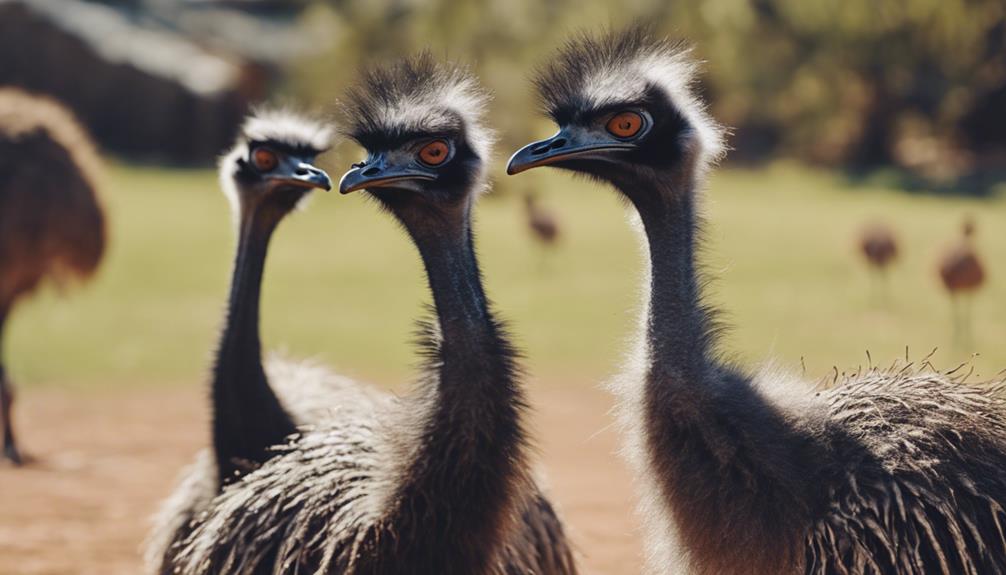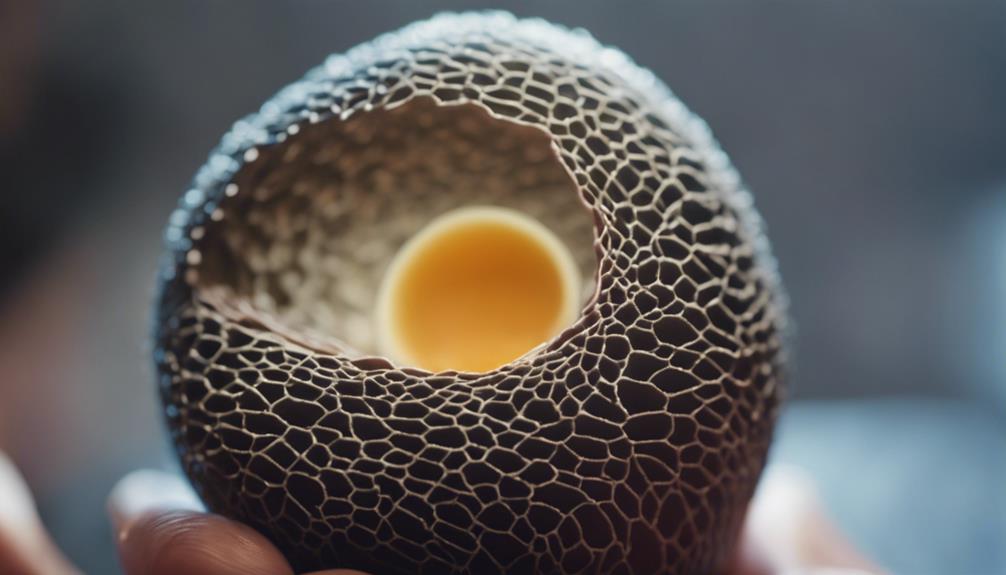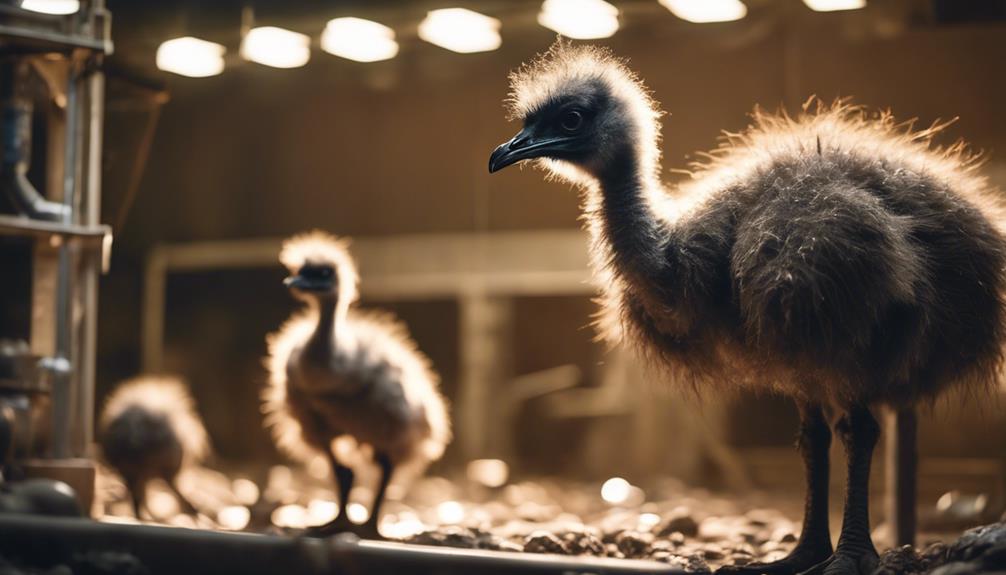
When it comes to understanding the intricacies of emu breeding, it's essential to grasp the intricate science behind their reproductive processes. From the complexities of their mating behavior to the meticulous care required during incubation and chick rearing, every step plays a crucial role in successful breeding outcomes. By delving into the fascinating world of emu reproductive biology, you'll uncover a wealth of knowledge that sheds light on the secrets behind fostering healthy emu populations.
Key Takeaways
- Emus have unique reproductive biology and complex mating rituals.
- Factors like nutrition, genetics, and environmental conditions impact fertility.
- Breeding season manipulation and monitoring health optimize reproductive success.
- Guidelines for egg incubation, chick rearing, and health maintenance ensure breeding success.
- Future trends include genetic techniques, specialized diets, and artificial insemination for efficiency.
Emu Reproductive Biology

Emus possess a unique reproductive biology characterized by a complex mating ritual and the production of large, dark-green eggs. These majestic birds reach sexual maturity at around two years of age. Female emus are the dominant gender in the mating process, selecting their partners and initiating courtship. During courtship, males perform a fascinating dance, vibrating their inflated necks and emitting deep grunting sounds to attract females.
When a female chooses her mate, they engage in a ritualistic dance involving mutual circling, head bobbing, and soft grunting. The females are polyandrous, meaning they can mate with multiple males during a breeding season. Once a female has selected a male, she'll lay a clutch of eggs in a communal nest that the male will then incubate for around 8 weeks. Emu eggs are the largest of any bird species relative to body size, with a dark-green coloration that helps them blend into their surroundings for protection.
Mating Behavior and Cycles
Detailed observations of emu mating behavior reveal intricate cycles of courtship rituals and reproductive activities that underscore the complexity of their breeding dynamics. Emus, with their striking size and plumage, engage in a series of behaviors that are essential for successful reproduction. Here are five key aspects of emu mating behavior and cycles:
- Vocalizations: Emus produce deep booming sounds to attract mates and establish dominance within the group.
- Dancing Displays: Male emus perform elaborate dances, including head swaying and feather fluffing, to court females.
- Mate Selection: Females are selective and may assess male quality based on dance performance and overall health.
- Nesting Behavior: After mating, females take the lead in nest-building, creating a shallow depression in the ground.
- Pair Bonding: Emus form monogamous pairs during the breeding season, with both parents sharing nesting and incubation responsibilities.
Understanding these behaviors is crucial for managing emu breeding programs effectively and ensuring the success of captive breeding initiatives.
Egg Formation and Incubation

In the process of emu breeding, the intricate formation and incubation of eggs play a crucial role in the reproductive cycle. Female emus typically lay eggs every three to four days during the breeding season, with a clutch size ranging from 7 to 10 eggs. The formation of emu eggs takes approximately 7 to 10 days within the reproductive tract of the female before being laid. Emu eggs are large, averaging around 5 inches in length and weighing 1-2 pounds, with a dark green coloration that helps camouflage them in the wild.
After being laid, emu eggs require careful incubation to ensure successful hatching. Emus have a unique incubation process where both male and female emus take turns incubating the eggs. The incubation period lasts for about 50-56 days, during which the emus diligently rotate the eggs to ensure uniform heat distribution. This careful attention is vital for the development of the embryos inside the eggs, ultimately leading to the successful hatching of healthy emu chicks.
Factors Affecting Fertility
The reproductive success of emus is significantly influenced by various factors that can impact fertility rates. To ensure optimal breeding outcomes, it's crucial to consider the following:
- Nutrition: Adequate nutrition is essential for both male and female emus to support reproductive functions and maintain overall health.
- Age: Emus reach sexual maturity at around two years of age, with peak fertility occurring between three to seven years old.
- Environmental Conditions: Factors such as temperature, humidity, and stress levels can affect the breeding behavior and fertility of emus.
- Genetics: Selecting breeding pairs with desirable genetic traits can enhance fertility rates and produce healthier offspring.
- Health Status: Regular health checks, vaccinations, and disease prevention measures are vital to ensure optimal reproductive health in emus.
Breeding Season Considerations

Considering the timing of breeding seasons is crucial in maximizing reproductive success in emus. Emus are seasonal breeders, with their breeding season typically occurring during the cooler months of autumn and winter. During this period, the length of daylight influences hormonal changes in emus, triggering the onset of breeding behavior. It's essential to ensure that emus have access to a suitable environment and appropriate nutrition during the breeding season to support successful reproduction.
In captivity, emu breeders often manipulate the breeding season by controlling factors such as lighting and temperature to mimic the natural conditions that stimulate breeding behavior. This manipulation can help synchronize breeding pairs and optimize reproductive outcomes. Additionally, monitoring the health and condition of breeding emus is vital during this period to address any potential issues promptly.
Genetic Diversity and Selection
When delving into the realm of Emu breeding, one must carefully assess genetic diversity and make strategic selections to enhance desirable traits and ensure the long-term health and vitality of the breeding population. Genetic diversity forms the foundation of a robust breeding program, allowing for adaptability and resilience in the face of environmental challenges.
Here are key considerations for genetic diversity and selection:
- Pedigree Analysis: Conduct thorough assessments of the lineage and ancestry of breeding emus to identify desirable genetic traits.
- Inbreeding Avoidance: Vigilantly steer clear of inbreeding to prevent the accumulation of harmful genetic mutations within the population.
- Selective Breeding: Employ precise selection criteria to promote the transmission of favorable genes and improve overall breeding outcomes.
- Genetic Testing: Utilize advanced genetic testing methods to screen for hereditary diseases and ensure the health of future generations.
- Population Management: Implement strategies to maintain optimal genetic diversity levels and prevent the loss of valuable genetic variations.
Artificial Insemination Techniques

To enhance breeding efficiency and genetic diversity in Emus, mastering advanced artificial insemination techniques is imperative for modern breeders. By utilizing artificial insemination, breeders gain control over the breeding process, enabling the selection of desirable genetic traits while expanding the gene pool. Here are some key artificial insemination techniques commonly used in Emu breeding:
| Technique | Description |
|---|---|
| Cloacal Insemination | Involves depositing semen directly into the female's cloaca for fertilization. This method requires skill and precision. |
| Surgical Insemination | A more invasive technique where semen is deposited into the oviduct via surgery. This method is highly effective but requires specialized training. |
| Transcervical Insemination | Involves passing a catheter through the cervix to deposit semen directly into the oviduct. This technique requires expertise to avoid injury and ensure successful insemination. |
Mastering these advanced techniques empowers breeders to optimize breeding outcomes, enhance genetic diversity, and maintain the health and vitality of Emu populations.
Incubation Management Strategies
In Emu breeding, implementing precise incubation management strategies is essential for ensuring optimal hatch rates and chick health. To maximize success, follow these key strategies:
- Temperature Control: Maintain a consistent temperature of around 97-98 degrees Fahrenheit in the incubator to mimic natural conditions.
- Humidity Regulation: Keep humidity levels between 25-50% during the first 25 days, then increase to 60-70% for the final days before hatching.
- Egg Turning: Regularly turn the eggs at least 3-5 times a day to prevent the embryo from sticking to the shell membrane.
- Candling: Use a candling light to monitor embryo development and remove any infertile or rotten eggs to prevent contamination.
- Ventilation Management: Ensure proper airflow within the incubator to provide fresh oxygen and remove harmful gases that can build up.
Chick Rearing and Care

Maintain a precise environment in the brooder for optimal chick rearing and care. Ensure the brooder temperature is set at 95-100 degrees Fahrenheit during the first week, gradually decreasing by 5 degrees each week until reaching the ambient temperature. Utilize infrared bulbs or heat lamps to provide consistent warmth, allowing chicks to move freely between warm and cooler areas. Monitor humidity levels between 50-70% to prevent dehydration and promote healthy growth. Provide a balanced diet of starter feed containing essential nutrients such as protein, vitamins, and minerals crucial for chick development.
Implement a regular cleaning schedule to maintain a hygienic environment, reducing the risk of infections. Use clean bedding like straw or wood shavings to keep the brooder dry and comfortable. Monitor chick behavior closely for signs of distress or illness, such as lethargy, abnormal vocalizations, or reduced appetite. Handle the chicks gently to minimize stress and promote socialization. By adhering to these precise rearing practices, you can ensure the health and well-being of your emu chicks, setting the foundation for successful breeding endeavors.
Health and Nutrition for Breeding Emus
Ensure optimal breeding success for your emus by carefully managing their health and nutrition needs. Emus require specific care to thrive and reproduce successfully. Here are essential considerations:
- Balanced Diet: Provide emus with a well-rounded diet containing proteins, fats, vitamins, and minerals to support their reproductive health.
- Ample Water Supply: Ensure emus have constant access to clean water to maintain hydration and support their metabolic processes.
- Regular Veterinary Check-ups: Schedule routine check-ups with a specialized avian veterinarian to monitor the health of your breeding emus.
- Parasite Control: Implement a parasite control program to prevent infestations that can compromise the health and breeding potential of your emus.
- Optimal Living Conditions: Create a stress-free environment with adequate space, shelter, and cleanliness to promote the overall well-being of breeding emus.
Breeding Challenges and Solutions

To optimize the breeding success of your emus, address common challenges through strategic management and proactive solutions. One key challenge in emu breeding is ensuring optimal breeding conditions. Emus are sensitive to changes in their environment, so maintaining stable temperatures and humidity levels is crucial. Additionally, providing a balanced diet rich in essential nutrients such as protein and vitamins is vital for successful breeding.
Another challenge is managing aggressive behavior during mating season. Male emus can become territorial and aggressive, which may lead to injuries or disrupted breeding activities. To address this, consider separating aggressive males or providing larger breeding spaces to minimize conflicts.
Furthermore, fertility issues can impede breeding success. Monitoring the reproductive health of your emus through regular check-ups and implementing breeding programs that consider genetic diversity can help overcome fertility challenges.
Future Trends in Emu Breeding
Addressing the evolving demands of emu breeding entails staying informed about emerging advancements and innovative practices shaping the future of the industry. Emu breeders must remain vigilant and adapt to these trends to ensure continued success in this specialized field.
Here are some future trends in emu breeding to keep an eye on:
- Genetic Selection: Utilizing advanced genetic techniques to enhance desirable traits in emus.
- Nutritional Optimization: Developing specialized diets to improve emu health and reproduction.
- Artificial Insemination: Implementing AI to increase breeding efficiency and genetic diversity.
- Health Monitoring Technologies: Incorporating wearable tech for real-time health tracking of emus.
- Market Diversification: Exploring new markets and product opportunities to maximize profitability.
Frequently Asked Questions
How Do Emus Establish Dominance Within a Breeding Group?
To establish dominance within a breeding group, emus utilize displays of power such as puffing up their feathers, making loud calls, and engaging in physical confrontations. The dominant emu gains control over resources and mates.
What Are the Potential Risks of Inbreeding in Emu Populations?
When breeding emus, beware of inbreeding risks. It can weaken genetic diversity, leading to health problems and decreased resilience. To maintain a strong population, always prioritize genetic variation and avoid close bloodline matings.
Can Emus Be Bred in Captivity Without Impacting Their Wild Counterparts?
You can breed emus in captivity without negatively affecting wild populations by implementing strict genetic management protocols, maintaining diverse breeding stock, and ensuring controlled releases if reintroduction is necessary. Follow these guidelines for success.
Are There Any Unique Challenges in Breeding Emus in Different Climates?
Are there any unique challenges in breeding emus in different climates? Breeding emus in varying climates presents distinct hurdles due to temperature fluctuations impacting reproduction cycles and habitat requirements. Understanding these challenges is crucial for successful breeding outcomes.
How Do Emu Breeders Ensure the Health and Welfare of Breeding Pairs?
You ensure the health and welfare of breeding pairs by maintaining optimal living conditions, monitoring their diet, providing veterinary care, and implementing biosecurity measures. Regular health checks, proper nutrition, and a stress-free environment are paramount.
Conclusion
You have delved into the intricate world of emu breeding, where understanding their unique reproductive biology is key to success.
Did you know that emus lay large eggs, with an average size of around 5 inches in length and weighing up to 1 pound? This statistic highlights the impressive reproductive capabilities of these fascinating birds and the importance of careful breeding practices to ensure their health and vitality.
Exciting advancements in genetic techniques and technology continue to shape the future of emu breeding.




